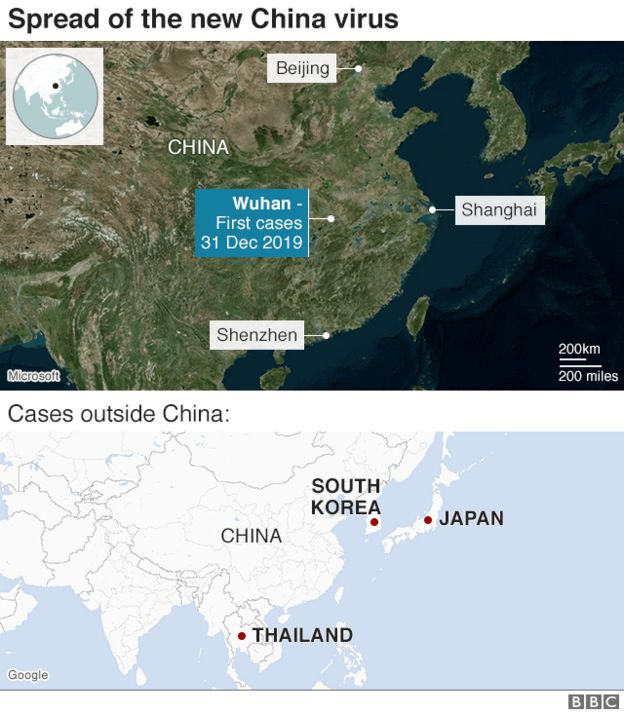Share the post "New China virus: Fourth person dies as human-to-human transfer confirmed"
A fourth person in China has died from a new virus that has spread rapidly across the country, as authorities confirmed that it can be passed from person-to-person.
A 89-year-old man was the latest victim of the new strain of coronavirus, which causes a type of pneumonia.
He lived in Wuhan, the city at the centre of the outbreak.
More than 200 cases have now been reported across major cities in China including Beijing and Shanghai.
The World Health Organization (WHO) is considering declaring an international public health emergency over the virus – as it did with swine flu and Ebola. The decision will be made in a meeting on Wednesday.

China’s National Health Commission on Monday confirmed for the first time that the infection could be transmitted from human-to-human. It said two people in Guangdong province had been infected in this way.
In a separate statement, the Wuhan Municipal Health Commission said at least 15 medical workers in Wuhan have also been infected with the virus, with one in a critical condition.
The workers presumably became infected with the virus due to contact with patients. All of them are being kept in isolation while being treated.
Where has the virus spread?
The disease was first identified in Wuhan, a central Chinese city of 11 million people, late last year. There are currently 218 confirmed cases of the virus in China, according to the WHO.
A handful of cases have also been identified abroad: two in Thailand, one in Japan, and another in South Korea. Those infected had recently returned from Wuhan.

Authorities in many countries, including Australia, Singapore, Hong Kong, Taiwan and Japan have stepped up screening of air passengers from Wuhan. US authorities last week announced similar measures at airports in San Francisco, Los Angeles and New York.
In Australia, a man who had travelled to Wuhan has been placed in isolation and is undergoing tests. China is the largest source of tourists to Australia, with more than one million people visiting last year.
How fast is it spreading?
There are fears that the virus could spread swiftly – and further across the country – as millions of people across China prepare to travel home for the Chinese New Year holidays later this week.

This mass movement of people could also mean that authorities will not be able to monitor further spread of the disease.
And experts say there already could be many cases going undetected.
A report by the MRC Centre for Global Infectious Disease Analysis at Imperial College London suggested there could be more than 1,700 infections. However, Gabriel Leung, the dean of medicine at the University of Hong Kong, put the figure closer to 1,300.
The outbreak has revived memories of the Sars virus – also a coronavirus – that killed 774 people in the early 2000s across dozens of countries, mostly in Asia, and which China was accused of initially covering up.
Analysis of the genetic code of the new virus shows it is more closely related to Sars than any other human coronavirus.
Chinese President Xi Jinping has called for “all-out efforts” to control the outbreak, according to state media, including quickly making information available and taking measures to “guide public opinion”.
What do we know about the virus?
The virus, known also as 2019-nCoV, is understood to be a new strain of coronavirus that has not previously been identified in humans.
It is believed to have originated from infected animals at a seafood and wildlife market in Wuhan.

Coronaviruses are a broad family of viruses, but only six (the new one would make it seven) are known to infect people.
The World Health Organization has advised people to avoid “unprotected” contact with live animals, thoroughly cook meat and eggs, and avoid close contact with anyone with cold or flu-like symptoms.
Signs of infection include respiratory symptoms, fever, cough, shortness of breath and breathing difficulties.
bbc